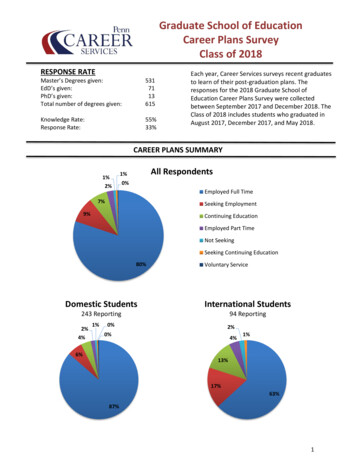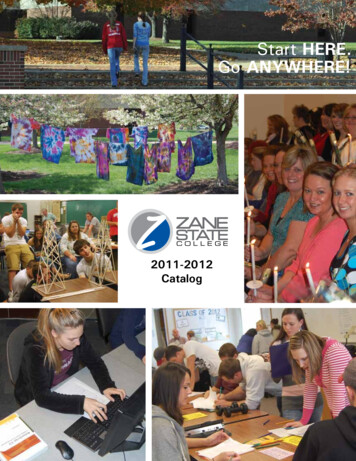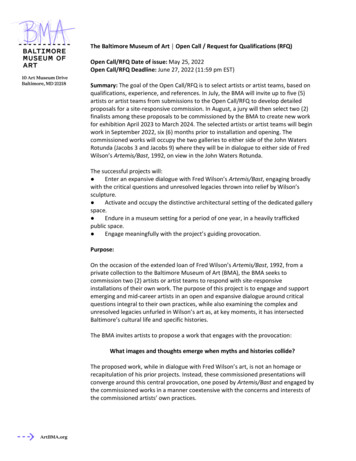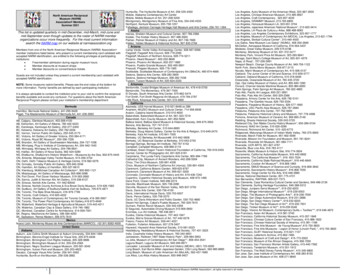
Transcription
CURATORMining the Museum:An InstallationConfronting HistoryLISA G . CORRINWhat is a museum anyway? Or a curator for that matter? And whatis an “audience”? Do museums have the corner on historical“Truths”? Mining the Museum, an installation by Fred Wilson,provided an opportunity to reflect on these questions. Presentedfrom April 2, 1992, to February 28, 1993, Wilson’s installation wasmade possible through a unique collaboration between The Contemporary and the Maryland Historical Society (MHS), two Baltimore-based museums.Founded in 1989, The Contemporary’s mission is to explore theconnections between the art of our time and the world we live in.The museum encourages interaction between artists and audiencesand directly involves communities in the development, implementation, and evaluation of its programs. The Contemporary worksout of a permanent administrative facility but presents exhibitionsin temporary locations; its concept of a “collection” consists ofplacing art in community settings on long-term loan.The MHS is a 150-year-old institution with an important collection housed in a permanent museum. Its fifty-plus staff membersoversee many thousands of objects ranging from decorative arts,paintings, and sculpture to extensive archives and a library ofMaryland history. It is in many ways typical of large, establishedstate historical museums across the country.In May 1991, The Contemporary opened its first internationalexhibition in the former Greyhound Service Terminal, located nearthe MHS. George Ciscle, The Contemporary’s director, and I paida social call on the society’s director, Charles Lyle, to introduceLisa Corrin was co-curator of Mining the Museum. She is CuratorlEducator atThe Contemporary, 601 North Howard Street, Baltimore, MD 21201,302
36l4 1993ourselves. We talked at length about the differences between theways our respective institutions operate. Lyle expressed his desireto have his institution deal with current concerns and public interests and to develop an audience more representative of the community’s cultural diversity.Coincidentally, The Contemporary had been considering a project with Fred Wilson and had invited him to Baltimore to visitmany of the city’s museums to choose a permanent collection hewould like to work with. Wilson’s first choice was the MHS.The Contemporary returned to the MHS with a suggestion: athree-way collaboration with Fred Wilson in which he would createan installation artwork during a one-year residency period. Ourstaffs would use the experience as an opportunity for a self-studyto help us identify new approaches to interpreting collections,shaping future acquisition policies and programs, and expandingour audiences. Wilson would have access to the MHS collection asa “gold mine” of ideas and reinstall it from his own point of view.Then Mining the Museum began to take shape. We agreed thatwhatever objects Wilson chose would be made available to him foruse in the installation.The exhibition was designed to address problems we felt were ofconcern to many museums, regardless of their discipline. The aimwould be to confront the difficulty of putting theories of diversityand historical revisionism into practice and to offer a model forchange responsive to our particular community. The directors ofthe two organizations felt strongly that presenting the exhibitionconcurrently with the 1992 American Association of Museums annual conference in Baltimore might catalyze provocative dialoguewithin the profession.ABOUT WILSON’S WORKFred Wilson is an installation artist of African-American and Caribdescent. His entry into the museum world began with free-lanceassignments in the education departments of a number of museums, including the American Museum of Natural History, TheMetropolitan Museum of Art, the Whitney Museum of AmericanArt, and the American Crafts Museum. More recently, he has beeninvolved with arts organizations as a museum educator, a gallerydirector, and a practicing artist.Until Mining the Museum, Wilson’s installations had used reproductions and fabricated artifacts in “mock museums” that haddrawn attention to the ways in which curatorial practices affect ourinterpretation and understanding of museum collections. Wilson’s303
CURATOR“museums” underscored the fact that history is an act of interpretation and that contemporary events are part of its flux. His workhas provided a savvy and thought-provoking critique of the museum environment.His insights first surfaced in Rooms with a View: The StruggleBetween Culture, Content and Context in Art, a project he curatedfor the Bronx Council of the Arts in 1987. Three distinct spacessimulated different display environments: ethnographic and Victorian museums and a contemporary gallery. In each room, Wilsonplaced different works of art by thirty artists, surrounded by theaccouterments appropriate to the space. The ethnography museumgrouped objects according to type, with vague labels identifyingthe artistic medium but not the maker. The Victorian museum gavethe objects a rarefied disposition, suggesting precious antique objets d’art through selective lighting and ornate pedestals. The“white cube” gallery gave the works the necessary cutting-edgemystique to certify them as works of contemporary art.The new contexts so thoroughly transformed the audience perceptions of the artworks that Wilson decided to take on “the museum.” Describing his reasons, Wilson said, “It is there that thoseof us who work toward alternative visions . . . get hot under thecollar and decide to do something about it.”Visitors to The Colonial Collection (1991) at the Gracie MansionGallery (no longer in existence) viewed African masks blindfoldedwith the flags of their French and British colonizers and otherslabeled “Stolen from the Zonga tribe,” highlighting how museumeuphemisms whitewash the acquisition of such objects. These“spoils” were displayed in dramatically-colored spaces with theatrical lighting, sometimes animated with the addition of video special effects. This, according to Wilson, illustrated how a museumdisplay “anesthetizes their historic importance . . . [it] certainlycovers up the colonial history.”The proposed collaboration offered Wilson an opportunity towork with real museum objects and occupy the curatorial “hotseat,” putting his theories into practice in the environment curators operate in every day and with similar limitations.DEVELOPING THE EXHIBITIONPrincipals on the project from the two collaborating institutionswere the directors, the chief curator and the director of educationat the MHS, and the curator/educator and an intern at The Contemporary. The Contemporary raised the necessary funds304
36/4 1993( 25,000) and managed the budget. Public programming, publicrelations, and development of educational materials were implemented cooperatively. The Contemporary provided orientation tothe topic of installation art and the process of creating it for MHSstaff and docents.Wilson made all artistic decisions and set the project’s philosophical, aesthetic, and historical trajectory. He participated in allaspects of the project’s development and implementation, including education. He visited the society frequently over a one-yearperiod, and for two months prior to the opening, he remained onsite. He came to know the collections and other resources as wellas the society’s curatorial, registrarial, educational, and governance practices.Mining the Museum was not the first museum collaboration orthe first time an artist “curated” a collection or created a museumcritical work for a specific institution. But a self-study processimplicit in the installation made the project not only different as anexhibition but an intervention. Throughout the project, an ongoingevaluation of the collaborative process and the impact of the installation was carried on. It examined commonly-held definitionsof “museum,” “history,” “exhibition,” ‘‘curator,” “artist ,” “audience,” “community,” and “collaboration.” The curators created a “think sheet,” a series of topics developed to measurechanges in the way individuals saw themselves, the artist, and theirinstitutions during the development of the installation. Wilson wasassisted in his research by independent volunteers who had expertise in African-American local and state history, astronomy, andmuseum history. The curators gave Wilson entry into the less-wellknown parts of the museum and shared historical informationabout the objects.AWALK THROUGH THE EXHIBITIONThe exhibition investigated both the African-American and NativeAmerican experiences in Maryland, using art and artifacts from theMHS collection that either had never been seen before or hadnever been viewed in this context.Personal history forms the basis of Wilson’s engagement withthe past. Objects, he believes, become “generic and lifeless” outside the context of personal experience. “I look at the relationshipbetween what is on view and what is not on view.” Wilson’s fearof imposing a personal morality on others led him to use the questioning process as the organizing principle of his work.305
CURATORTo encourage visitors to begin questioning immediately, the curators created a handout that was posted in the elevator. It read:What is it?Where is it? Why?What is it saying?How is it used?For whom was it created?For whom does it exist?Who is represented?How are they represented?Who is doing the telling? The hearing?What do you see?What do you hear?What can you touch?What do you feel?What do you think?Where are you?Mining the Museum employed display techniques that are sec-ond nature to most curators: artifacts, labels, selective lighting,slide projections, and sound effects. But they were used to exploreour “reading” of historical truth through sometimes startling juxtapositions of objects representing vastly different historical“facts,” revealing stereotypes and contrasting power and powerlessness. (Highlights from the installation follow.)The installation opened with the silver and gold “Truth TrophyAwarded Until 1922 for Truth in Advertising,” surrounded by threewhite pedestals bearing white marble busts of historic personagesand three empty black pedestals. It encapsulated the issues at theheart of the exhibition. Whose truth is on exhibit? Whose history isbeing told? Wilson thus established that Mining the Museum wouldexplore not what objects mean but how meaning is made when theyare “framed” by the museum environment and museum practices.Those left out of the museum’s historical narrative were literallygiven voice in a room where nineteenth-century paintings were ondisplay. When a viewer stepped toward the dimly lit works of art,306
The three white busts in the opening exhibit were ofNapoleon, Henry Clay, and Stonewall Jackson(none of whom had particularly significant impacton Maryland history). The three empty black pedestals were labeled “Harriet Tubman,” “BenjaminBanneker,” and “Frederick Douglass” (all Marylanders). Where are the busts of these prominentpersonages? Did no one see fit to “collect” or commemorate them? The Truth Trophy exhibit set thestage for the exhibition experience.Cigar-store Indians were carved on commission fromstore owners. Here they turned their backs to viewersand faced photographs of Native Americans. The label,“Portraits of Cigar Store Owners.” implied that thelumbering wooden figures tell us more about the stereotypes held by their owners than about Native Americans.This Ernst Fisher painting was given two labels,“Country Life” and “Frederick Serving Fruit.”Asking, “Where am I in this painting?” Wilson inserted himself in the place of the black serving boywho was or was not “seen,” depending on whichlabel one chose to apply. (Photo: JefiGoldman,courtesy of the Maryland Historical Society.)In “Modes of Transport” a Ku Klux K h n W ,discovered in a house in nearby Towson and given by ananonymous donor, took the place of pram linens in anantique baby carriage. (Photo: Jeff Goldman. courlesyof the Maryland Historical Society.)“Metalwork” juxtaposed Baltimore repoussC silverware with slave shackles, making the point that a luxutyeconomy was builr on the slavery system. (Photo: JeffGoldman, courtesy of the Maryland Historical Society.)
In “Cabinetmaking, 1820-1960,” a whipping post (until 1938 located in front of aBaltimore jail) was raised on a platform surrounded by period chairs, each suggesting a distinct sociul class: clergy, bourgeois, blueblood, businessman. Thechairs appeared to gaze at the crucfi-like form in the center. A child respondedto the exhibit with this drawing. (Courtesy of The Contemporary.)“The rebellion room” provided insight into the mythological proportions thatblacks took on in the white imagination. Here, Fred Wilson shows a doll house inthe MHS permanent collection. A room of the same house in the exhibit installation tells a very different story. Disproportionately large and small objects areused to tell it. A crudely made, gigantic figure of an old black man is surroundedby tiny white dolls, apparently massacred. (Photographs by Jefl Goldman, courtesy of the Maryland Historical Society, and by Mary Connor and Anna Sobaski,courtesy of The Contemporary.)
36/4 1993spotlights and hidden sound effects were triggered to highlight theAfrican-American children represented. A boy asked, “Am I yourbrother?” “Am I your friend?” And, alluding to his metal collar,“Am I your pet?” The names of slaves depicted in a rare paintingof workers in the fields were added to the label after the plantationowner’s inventory book listing them along with other householditems and animals was found in the archives.Examples of how the museum classification system inadvertently represses the layered and complex history behind objects wasillustrated in “Modes of Transport,” “Metalwork,” and “Cabinetmaking, 1820-1960.” The first of these examined who traveled incolonial Maryland-why and how. A model of a slave ship wasshown alongside a once-elegant sedan chair; a painting depicting asimilar chair highlighted who carried whom. A Ku Klux Klan hoodreplaced the customary linens in an antique pram; nearby was aphotograph of black “nannies” pushing similar carriages. The suggestion that children absorb their parents’ racial stereotypes earlyon was clear. Disproportionate sizes of objects displayed togetherconveyed a sense of power or the lack of it. On display in a spacefocusing on runaway slaves were decoy ducks and a toy figure ofa running black soldier “targeted” by a large punt gun used inhunting the birds in Chesapeake Bay. In “the rebellion room,”Wilson inverted this relationship. Miniature white figures in a dollhouse were dwarfed by a black doll dominating them. A diary ondisplay revealed panic on the part of white landowners of a “Negrouprising,” reflecting the source of this nightmarish vision.Some objects were brought into the light here for the first time.A rocking chair, a basket, and a jug made by enslaved AfricanAmericans were displayed along with objects made by Africans inthe colony for freed slaves in Liberia. Only the jug, made by“Melinda,” had been exhibited; few had seen the Liberian objects.Found in storage, a wooden tourist box with its ticket of passage toAfrica led to the identification of the “new” objects. The box hadbeen given to the MHS in the mid-nineteenth century by a memberof the Colonization Society. At the end of the corridor hung apainting, “Maryland in Liberia,” by John H.B. Latrobe, founderof the MHS and an active member of the Colonization Society.The final section focused on the aspirations, dreams, andachievements of African Americans. The focal point was a journalkept by the astronomer and mathematician Benjamin Banneker(1731-1806). Software that could generate images of the night skyas Banneker saw it was loaded into an IBM computer. (The computer was labeled.) Drawings from the journal were projected on309
CURATORthe wall. Banneker was hired by Thomas Jefferson to help surveythe area that became Washington, DC, and the two men corresponded. The journal contains an article that Banneker sent toJefferson urging him to abolish slavery and saying: “Sir I freelyand Chearfully acknowledge that I am of the African race.” Thebook tells the story of a free black who was no less immune to theoppression of the slavery system than his enslaved brothers andsisters.The installation ended with a globe used in Banneker’s time; byformally and metaphorically echoing the opening Truth Trophy,the installation came full circle.EDUCATIONAL PROGRAMS AND OUTREACHThe museum educators reconsidered their usual approaches to interpretation and public programming. Their aim would be to stimulate debate and encourage active audience engagement with thematerial.An educational handout was produced after the exhibitionopened. “Do you have questions about Mining the Museum?” wasbased on questions most frequently asked of and reported byguards, docents, receptionists, and gallery-store staff. Visitors received it at the end of the installation, so that the active questioningprocess of their experience would not be lost. It provided background information on such topics as the lives of historical personages, information about some of the objects, and an explanation ofinstallation art.Programs for the public took place at the MHS. Open studiovisits were held weekly just prior to the opening so that the publiccould gain first-hand experience of Wilson’s working process andhave a chance to speak with him. Workshops for the docents oncontemporary art focused on the installation medium and how artists today often address social and political issues in their work.They also included tours of the MHS with the artist. Discussionsabout the exhibition as a work of contemporary art were conductedby nine area artist/docents each Saturday. Other public lecturesincluded: “Contemporary Artists and Cultural Identity,’’ “African-American Women in Maryland 1750-1860,” and “Free atLast,” a dramatic reading of primary documents related to slaveryand abolition in Maryland.“Exhibiting Cultures,” a continuing studies course at the JohnsHopkins University, was based on the book Exhibiting Cultures:The Poetics and Politics of Museum Display (Karp and Lavine,310
36/4 19931991). Lectures took a critical look at the challenges curators of alldisciplines face when exhibiting artifacts from cultures other than(and including) their own. The final class brought together scholarsin the fields of art history, anthropology, and African-Americanhistory, including Ivan Karp, to present papers on the issues raisedby the installation. The artistldocents were given scholarships toattend the course.AUDIENCE RESPONSEA community exhibit, on view for the final month of the exhibition,chronicled audience participation in the project, including drawings, essays, creative writing by children and art students as well asresponses to a questionnaire asking for reactions. Visitors hadbeen requested to hang them on the bulletin board to create adialogue among members of the audience.Almost every evaluation received remarked on the emotionalimpact of the installation. The subtleties of Wilson’s work were notlost on the young.When I go to a museum, I hope to say “Wow” but today I was thinking“Wow!” in a different way.I like that he asks questions and doesn’t answer them.Child’s drawing and a comment: “When I saw the baby carriage with the mask itmade me mad. When he showed the punting gun pointing to the black I was sad.”(Courtesy of The Contemporary.)And from adults:You always have to question information presented because even if presentedas “lruth” it is always from a specific cultural point of view. (Attorney)It interested me in seeing Maryland History in terms of an African Americanalthough I am white. I’ve never been interested in seeing this museum beforethis show.I want a sense of understanding history as good or bad in order to repeat it orto discard it so as not to repeat it. (Retired police officer)I found my history in this exhibition. My ancestors were never slave owners. . . but as a Caucasian American, I share some responsibility for the continuing state of racial strife today. (Immigrant economist)311
CURATORCan you force all of Baltimore to see this? (Unemployed white male)Never have I witnessed any form of artwork that has had such an emotionaleffect on me. (College student)Not all responses were positive.Mining the Museum has the ability to promote racism and hate in young Blacksand was offensive to me. (Retired dentist)I found Mining the Museum “artsy” and pretentious. It was a waste of spacethat could be used to better purpose. A museum should answer questions notraise questions unrelated to the subject. (Engineer)It snookered me.I liked the pedestals without statues least because they were visually boringand emptiness is decidedly uninteresting, period. (Curator)DISCUSSION AND CONCLUSIONMining the Museum examined how the MHS had defined itself andhow this self-definition determines whose history has been included or excluded. It also spoke to how those excluded have cometo see the museum. It was about the power of objects to speakwhen museum practices are expanded and the artificial boundariesmuseums build are removed. It was about how deconstructing themuseum apparatus can transform the museum into a space forongoing cultural debate.It stimulated so much enthusiasm within the profession that children’s museums, natural history museums, science centers, and artmuseums suddenly wanted “Fred Wilsons” of their own; theywere encouraged to look at their own collections with a renewedsense of purpose and possibility. Two Wilson installations basedon permanent collections have taken place since the installation atthe MHS: The Spiral ofArt History at the Indianapolis Museum ofArt and Museums: Mixed Metaphors at the Seattle Art Museum. Acondensed version of Mining the Museum is currently being developed as a permanent display at the MHS, using objects from theoriginal installation.Throughout the course of the collaboration, both institutions andthe artist have had to deal with problems that arose because ofassumptions we had about one another and our expectations forthe project. One of the greatest difficulties for the participants waslearning to adapt to one another’s working style. As one staff member stated, “We occasionally speak a somewhat different language.” Gradually, staff and docents began to realize that the waytheir jobs had been previously defined did not always apply to therole they had to assume for the installation. Wrote one staff member, “The insistence on secrecy and preserving the mystery of the312
36/4 1993work of art until the last possible moment made it difficult to planand, indeed, to schedule normal pre-exhibition activities, such asthe movement of artworks from storage to the installation space. Ittook a great leap of faith.”All project evaluations are being utilized to generate short- andlong-term goals concerning policies, practices, and future programming at both The Contemporary and the MHS. We continue toreflect on our respective missions and on the role a museum canplay in a rapidly changing world. The project offered our staffs apractical way to explore different methodologies and professionalpoints of view and to exchange ideas valuable for future collaborations. The docents are considering how their experiences mightbecome useful in giving tours in other parts of the museum. Miningthe Museum also generated a critical exchange of ideas betweenlocal artists, area cultural institutions, and our community.Finally, Wilson’s installation demonstrated dramatically thatcurrent issues are as legitimate a concern for history museums asthe distant past. Our audiences told us that they want to be challenged and feel it is appropriate that cultural institutions provide aforum to discuss issues of a controversial nature. Moreover, theycautioned us that if museums are to be truly diverse, they mustallow for questioning and be responsive to the questions they hear.Most important, we realized that the project would have been impossible without Fred Wilson’s residency. For, as one educatorstated, “only with the perspective and creative resources of anoutsider could . . . [any museum] undertake as self-critical andcreative a project as Mining the Museum.”ACKNOWLEDGMENTSThanks for the support of the project go to the Andy Warhol Foundation for theVisual Arts, the Maryland Humanities Council, the Maryland State Arts Council,and the Puffin Foundation and the Mid-AtlanticArts Foundation (M-AAF). Partsof this report are adapted from Arts Ink, the M-AAF journal (Fall, 1992). Thanksalso go to the volunteers and docents who were largely responsible for the successful interpretation of the installation, and to the directors, George Ciscle andCharles Lyle, to Jennifer Goldsborough, chief curator at the MHS, and Judy VanDyke, director of education at the MHS. For further information about the project, see Comn, Lisa G. (Ed.) (in press). Mining the Museum. Baltimore, MD:New Press. The book includes contributions by Lisa G.Comn, Ira Berlin, FredWilson, and Leslie King-Hammond.All photographs are by Mary Connor and Anna Sobaski, courtesy of TheContemporary, unless otherwise indicated.REFERENCEK q , Ivan,and Lavine, Stephen D. (Eds.) (1991). Exhibiting Cultures: The Poeticsand Politics of Museum Display. Washington, DC: Smithsonian Institution Press.313
jets d'art through selective lighting and ornate pedestals. The "white cube" gallery gave the works the necessary cutting-edge mystique to certify them as works of contemporary art. The new contexts so thoroughly transformed the audience per- ceptions of the artworks that Wilson decided to take on "the mu- seum."










